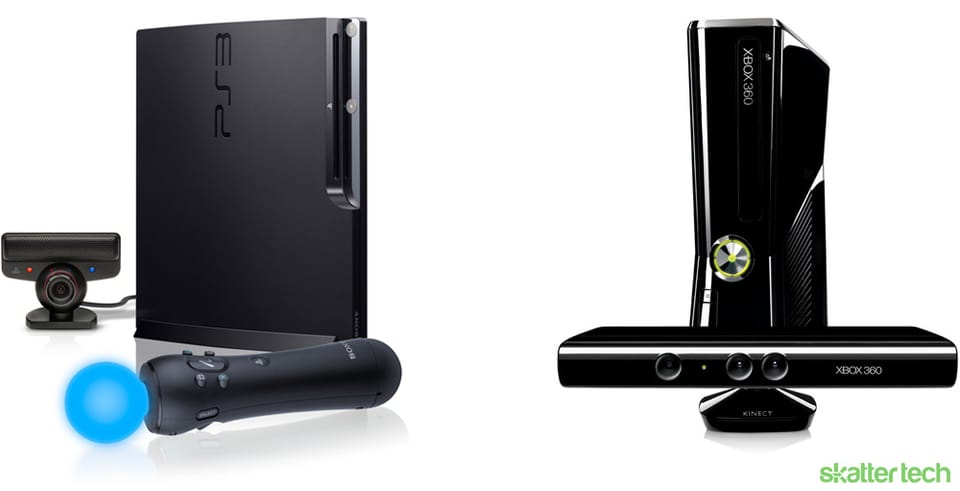Xbox Kinect vs. PlayStation Move

Microsoft Xbox Kinect
While I was quick to assume that controller-free gaming was far from being ready, Microsoft took the leap with Project Natal (now Kinect). Sony attempted the same thing just a few years ago with the PlayStation EyeToy, but it was far from practical and never caught traction with customers. The Kinect, however, pushes the limits by dumping the traditional controller. While it’s hard to imagine how games such as Gears of War 3 or Halo Reach will be played without controllers, upcoming titles such as Dance Central and Fitness Evolved make Microsoft’s vision for gaming clear.
The technology behind it is simple yet ingenious: a set of cameras and microphones detect your movement and listen to your voice. It truly makes you the controller, and no gloves, vests, or accessories are needed. It is unquestionably easier to use than the PlayStation Move or the Wii. It’s refreshingly exciting with its“Minority Report“-like features for waving a hand in mid-air to slowly scan back and forth through a movie. Even the ability to simply yell out “Xbox Pause” or “Xbox Play” without having to hold a controller is truly convenient. The only thing that’s not exciting is the price-point. While Microsoft hasn’t officially revealed numbers, most reports indicate that the Kinect will cost consumers nearly $150. While multiple players can use a single Kinect, the price might be a speed bump for potential buyers.
http://www.youtube.com/watch?v=aDkUxqosWqI&hd=1
While I’m positive that this technology will be great for family driven games, the true potential of the technology is probably not going to be apparent for some time. As Microsoft begins to offer more APIs for Kinect and developers begin taking advantage of them, I’m confident that gamers will see some exciting ideas. But for now, some issues are worth mentioning. For instance, there are slim chances that true gamers will consider staying on their feet all night long with Kinect. Voice commands may also become problematic if the sound from a home theater setup is too loud or if everyone begins yelling things. And while most demos were shown off in brightly lit situations, it’s hard to tell exactly how well the technology will work until the Kinect gets tested in an average living room.
Sony PlayStation Move
At first glance Sony’s latest creation, the PlayStation Move, appears to closely resemble the Nintendo Wiimote. However, there are a few differences in addition to the illuminated globe on top. While the Wii has a Nunchuck that’s tethered to the Wiimote, the PlayStation’s motion and navigation controllers offer more freedom by wirelessly connecting to the console. While the Wii uses an infrared sensor bar, the PlayStation Eye offers a camera and microphone for further interaction. It is true that the PlayStation Move technology isn’t revolutionary or groundbreaking; the components have been around for sometime already. Sony may have taken the safe route, but they also better implemented the idea into their console.
For serious gamers, the PlayStation Move is the best solution of the three consoles. For starters, it’s far more accurate and offers more control than the Kinect. With a joystick, a d-pad, and buttons in addition to camera tracking and motion capabilities, the PlayStation Move offers more control of a game. It’s something the Kinect, which can only track arms, legs, and body movement, simply can’t offer. The PlayStation Move also offers an unparalleled integrated 1:1 virtual movement experience in 3D space. The Wii, on the other hand, needs an addition Motion Plus accessory to simulate the same thing. When it comes to long hours of gaming, the Kinect gets tiring to play. Health benefits of physically engaging games aside, the PlayStation Move suits the average gamer better.
The PlayStation Move’s controllers offer a more traditional approach to gaming. A Sony spokesperson even assured us that most major titles would be entirely compatible with both the PlayStation DualShock controller and the Move controller. While the Move isn’t as convenient as the gesture and voice based control that the Kinect offers, it’s better for gaming at the moment. As for pricing, Sony announced that it would sell the Move motion controller for $49 and the Move navigation controller for $29. It’s a bit more affordable than the Kinect, but the bill can stack up when purchasing additional units for multiple players.
Final Thoughts
It would be unwise to try to predict which console will come out on top in 2010 until I can spend more time with the new hardware and game titles. After all, I did initially denounce the Wii since it’s graphics capabilities were years behind both the Xbox 360 or PlayStation 3, yet sales figures soon proved me wrong. As for the latest console hardware, both the Xbox 360 and PlayStation 3 have plenty of potential. With great graphics, a media center platform, and an online social network, Microsoft’s Xbox Kinect appeals to a large audience. Although slightly different, Sony’s PlayStation Move offers plenty as it paves the way into the realm of high-definition 3D gaming with Blu-ray movies and many upcoming exclusive game titles to back it. The new battle between consoles is clearly between Microsoft and Sony. The Nintendo Wii is in dire need of an upgrade.
Links: Xbox.com | PlayStation.com